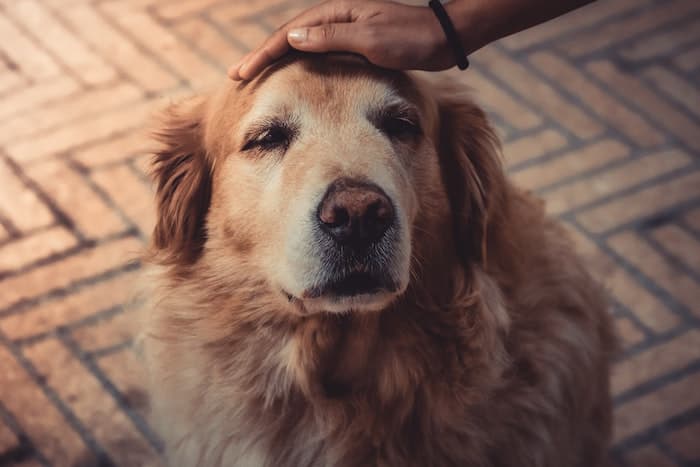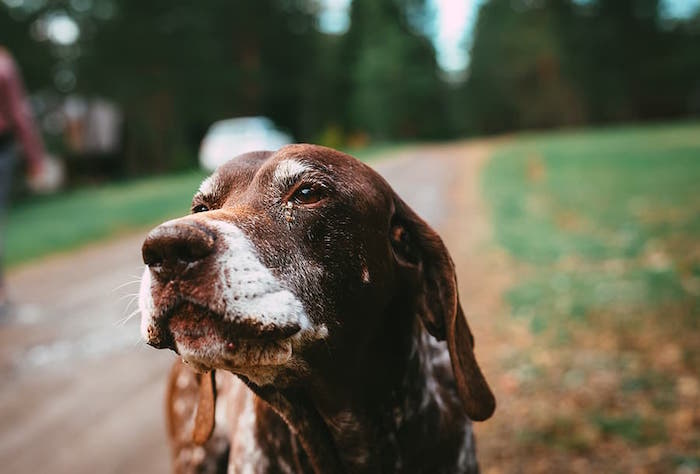Old dogs require special attention. To ensure your aging pet leads as fulfilling a life as possible for their age, provide them with comfort, monitor their health condition, revise their diet, and walking schedule.

When is a dog considered old?
A dog’s life span is not long, and the speed of aging depends on the breed of the dog. When a large breed pet turns seven years old, they have already reached a venerable age. For small breed dogs, old age comes later – at the age of eleven, and their lifespan is longer.
An attentive owner will recognize the signs of aging:
- teeth wear out;
- vision decreases;
- hairs on the head turn gray;
- appetite changes;
- problems with defecation and urination occur;
- temperament changes – activity decreases.
Nutrition
The diet of an aging dog should be special. It’s ideal if it’s chosen by a veterinarian, but the owner can also do it.
What should be in the diet:
- plant fiber – for the normal functioning of the digestive system;
- plant fats – these should replace animal fats;
- products rich in vitamins and minerals.
Older dogs should have limited fish and meat intake, so as not to overload the kidneys with protein-rich food. One third or a quarter of the total volume of consumed meat should be replaced with porridge and vegetables. The food should be minimally salted to avoid swelling. Make sure your pet regularly eats cottage cheese to strengthen bones, and drinks kefir. Ensure the dog drinks enough water and prepare vegetable soups.
The following should be avoided:
- bones;
- fatty meat;
- smoked meats and sausages;
- food from your table.
Owners of older dogs who eat prepared foods should choose canned food with the appropriate label. The composition should not include flavorings, preservatives, and other harmful substances, which only a young organism can cope with.
Feed the dog in small portions, but more often – this will make it easier for the digestive system. Older dogs are prone to obesity due to less activity. If you can’t feel the pet’s ribs, that’s a signal to feed less. And to ensure the animal does not suffer from a reduced diet, give them vitamin supplements recommended by the veterinarian.
If the dog is already having difficulty eating solid food, then grind it into mince or simply soften it to a softer consistency, meat and vegetables can be given in small pieces. Make sure the food is warmed to room temperature.

Veterinary Observations
An aging dog needs to be shown to the veterinarian regularly. Not all age-related diseases are curable, but in many cases, you can help the dog by easing their course. Owners of elderly dogs need to be prepared for the development of diabetes in their pet, the emergence of heart problems, kidney stones. Sometimes, only a doctor can recognize the first signs of diseases at an early stage in elderly pets. Hormonal changes in a dog’s body at this stage of life can provoke serious problems, such as the development of a tumor. Therefore, if a veterinarian recommends sterilizing the dog, it is better to listen to them. In the absence of contraindications to vaccinations, they should also be given. Infectious diseases are particularly dangerous for older dogs.
A problem area for aging dogs is their teeth. To prevent their loss, you need to periodically come to the veterinarian for oral sanitation and to address other problems. Possibly, the vet may notice that your pet is starting to develop cataracts – if no action is taken, the dog will lose its sight. Often, the owner is unable to independently recognize the symptoms of this disease.
Walks and Hygiene
With age, dogs lose interest in active pastime, and their daily routine needs to be reviewed. Even old dogs should not spend all their time on their favorite bed, as this will eventually weaken the muscles and overall negatively affect their health. Therefore, walks should not be canceled, but they should be made calmer and shorter. Let the dog just walk leisurely next to you.
Injuries heal worse in older dogs, so avoid encounters with young, aggressive dogs. And to prevent your pet from getting lost due to poor sensory functions, which no longer allow them to “read” marks like in their youth, try not to let them off the leash. Elderly dogs have poor hearing, so you simply won’t be able to call your ward back if they run too far.
Elderly dogs have worse control over their bladder and bowel – if you notice this, take your pet for walks more often. In addition to the morning and evening outings, it is advisable to organize one or two during the day.
Protect your pet from hypothermia – if you walked in wet weather, first dry its fur, give it warm food and drink. The room where the dog rests should also be warm. On frosty days, put a blanket or jumpsuit on it.
Taking care of the fur of an older dog is a must-do, involving regular brushing with a soft brush. This will keep the fur looking well-groomed and improve circulation. The owner will also need to periodically trim the pet’s claws. Elderly dogs are washed rarely – the hygienic procedure is replaced with cleaning with a special shampoo.
What to provide at home
Arrange a comfortable corner for the dog where it can rest as much as it wants. Let the family members respect the needs of the elderly pet and do not disturb it. To prevent the dog from wetting the bedding, use special puppy pads or put on pet diapers.
Avoid rearranging furniture – the dog has well studied what and where is located over the years. With age, it has become clumsy and is no longer always able to correctly calculate the trajectory of movement.
A dog’s character can change several times during its life. Old age also changes it, and often not for the better. The owner of an elderly dog needs to be patient with the animal – let it feel that you still love it, and provide a decent old age.
Related Reading
